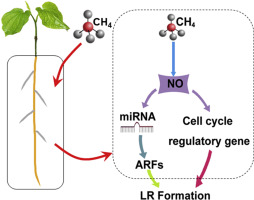当前位置:
X-MOL 学术
›
Plant Physiol. Biochem.
›
论文详情
Our official English website, www.x-mol.net, welcomes your feedback! (Note: you will need to create a separate account there.)
Methane-induced lateral root formation requires the participation of nitric oxide signaling.
Plant Physiology and Biochemistry ( IF 6.5 ) Pub Date : 2019-12-24 , DOI: 10.1016/j.plaphy.2019.12.029 Xinxin Jin 1 , Ying Li 1 , Rongfei Lu 1 , Pengfei Cheng 1 , Yihua Zhang 1 , Longna Li 1 , Ren Wang 2 , Jin Cui 1 , Wenbiao Shen 1
Plant Physiology and Biochemistry ( IF 6.5 ) Pub Date : 2019-12-24 , DOI: 10.1016/j.plaphy.2019.12.029 Xinxin Jin 1 , Ying Li 1 , Rongfei Lu 1 , Pengfei Cheng 1 , Yihua Zhang 1 , Longna Li 1 , Ren Wang 2 , Jin Cui 1 , Wenbiao Shen 1
Affiliation

|
Although methane (CH4)-induced lateral root (LR) formation has been discovered, the identification of downstream signaling compounds has yet to be fully elucidated. Here, we report a unique mechanism for the involvement of nitric oxide (NO) in the above CH4-mediated pathway in tomato (Solanum lycopersicum L.) and Arabidopsis thaliana. NO was produced rapidly in the root tissues of tomato seedlings when CH4 was administrated exogenously. The scavenging of NO with its scavengers prevented lateral root primordia formation and thereafter lateral rooting triggered by CH4. Gene expression analysis revealed that similar to the responses of sodium nitroprusside (SNP; a NO-releasing compound), CH4-induced SlCYCA2;1, SlCYCA3;1, and SlCDKA1 transcripts, and -downregulated SlKRP2 mRNA, were differentially abolished when endogenous NO was removed by its scavengers. Changes in the lateral root-related miRNA genes (SlmiR160 and SlmiR390a) and their target genes (SlARF16 and SlARF4), exhibited similar tendencies. Similar to those results in tomato, the addition of CH4 and SNP could obviously induce NO production and LR formation in Arabidopsis seedlings, which were correlated with the transcriptional profiles of representative LR-related genes. Combine with these findings in tomato and Arabidopsis thaliana, our results showed that NO might act, at least partially, as the downstream signaling molecule for CH4 control of lateral rooting.
中文翻译:

甲烷诱导的侧根形成需要一氧化氮信号的参与。
尽管已发现甲烷(CH4)诱导的侧根(LR)形成,但尚未完全阐明对下游信号传导化合物的鉴定。在这里,我们报告一氧化氮(NO)参与上述CH4介导的番茄(Solanum lycopersicum L.)和拟南芥中的CH4介导的途径的独特机制。当外源施用CH4时,番茄幼苗的根组织中迅速产生NO。用清除剂清除NO可以防止侧根原基形成,然后阻止CH4触发侧根。基因表达分析显示,与硝普钠(SNP;一种释放NO的化合物),CH4诱导的SlCYCA2; 1,SlCYCA3; 1和SlCDKA1转录物以及下调的SlKRP2 mRNA的反应相似,当内源性NO被其清除剂清除时,它们的差异被消除。侧根相关的miRNA基因(SlmiR160和SlmiR390a)及其靶基因(SlARF16和SlARF4)的变化表现出相似的趋势。与番茄结果相似,CH4和SNP的添加可以明显诱导拟南芥幼苗中NO的产生和LR的形成,这与代表性的LR相关基因的转录特征有关。结合番茄和拟南芥中的这些发现,我们的结果表明NO可能至少部分充当CH4控制侧根的下游信号分子。CH4和SNP的添加可以明显诱导拟南芥幼苗中NO的产生和LR的形成,这与代表性的LR相关基因的转录特征有关。结合番茄和拟南芥中的这些发现,我们的结果表明NO可能至少部分充当CH4控制侧根的下游信号分子。CH4和SNP的添加可以明显诱导拟南芥幼苗中NO的产生和LR的形成,这与代表性的LR相关基因的转录特征有关。结合番茄和拟南芥中的这些发现,我们的结果表明NO可能至少部分充当CH4控制侧根的下游信号分子。
更新日期:2019-12-25
中文翻译:

甲烷诱导的侧根形成需要一氧化氮信号的参与。
尽管已发现甲烷(CH4)诱导的侧根(LR)形成,但尚未完全阐明对下游信号传导化合物的鉴定。在这里,我们报告一氧化氮(NO)参与上述CH4介导的番茄(Solanum lycopersicum L.)和拟南芥中的CH4介导的途径的独特机制。当外源施用CH4时,番茄幼苗的根组织中迅速产生NO。用清除剂清除NO可以防止侧根原基形成,然后阻止CH4触发侧根。基因表达分析显示,与硝普钠(SNP;一种释放NO的化合物),CH4诱导的SlCYCA2; 1,SlCYCA3; 1和SlCDKA1转录物以及下调的SlKRP2 mRNA的反应相似,当内源性NO被其清除剂清除时,它们的差异被消除。侧根相关的miRNA基因(SlmiR160和SlmiR390a)及其靶基因(SlARF16和SlARF4)的变化表现出相似的趋势。与番茄结果相似,CH4和SNP的添加可以明显诱导拟南芥幼苗中NO的产生和LR的形成,这与代表性的LR相关基因的转录特征有关。结合番茄和拟南芥中的这些发现,我们的结果表明NO可能至少部分充当CH4控制侧根的下游信号分子。CH4和SNP的添加可以明显诱导拟南芥幼苗中NO的产生和LR的形成,这与代表性的LR相关基因的转录特征有关。结合番茄和拟南芥中的这些发现,我们的结果表明NO可能至少部分充当CH4控制侧根的下游信号分子。CH4和SNP的添加可以明显诱导拟南芥幼苗中NO的产生和LR的形成,这与代表性的LR相关基因的转录特征有关。结合番茄和拟南芥中的这些发现,我们的结果表明NO可能至少部分充当CH4控制侧根的下游信号分子。


























 京公网安备 11010802027423号
京公网安备 11010802027423号